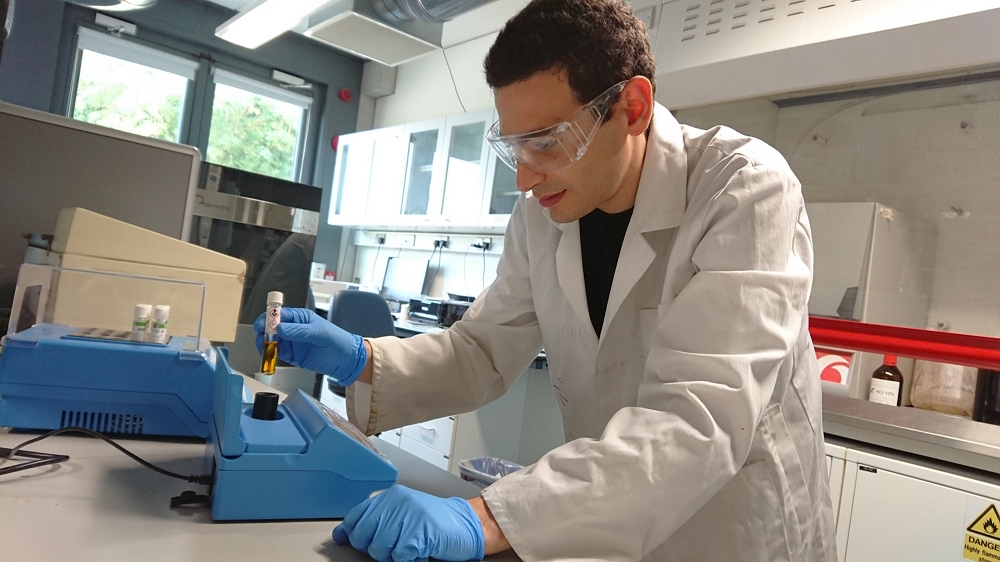Services for the Analysis of Sugar Degradation Products
Background
Hydrolysis biorefining technologies aim to produce biofuels and/or platform chemicals from the polysaccharides
of lignocellulosic biomass by breaking them apart into their constituent monosaccharide (single sugar) units.
This can be done in various ways, including using enzymes and chemicals. Furthermore, these technologies often involve a pre-treatment stage to
make the lignocellulosic matrix more amenable to subsequent hydrolysis and in many cases these pre-treatments can partially hydrolyse some of the polysaccharides.
Particularly when elevated temperatures and/or chemicals are employed in either pre-treatment or hydrolysis it can be possible for the production of the monosaccharide to not be the end-point of the process. Some sugars may be further degraded to a variety of potential products. This is important since these products can often be inhibitory to fermentation or can otherwise complicate subsequent downstream processing methods.
Particularly when elevated temperatures and/or chemicals are employed in either pre-treatment or hydrolysis it can be possible for the production of the monosaccharide to not be the end-point of the process. Some sugars may be further degraded to a variety of potential products. This is important since these products can often be inhibitory to fermentation or can otherwise complicate subsequent downstream processing methods.
However, some of these sugar degradation products can be valuable chemicals in their own right and technologies may target their production.
The types and concentrations of these sugar degradation products will be dependent on the feedstock, pre-treatment, and hydrolysis methods used and can
vary substantially with these parameters.
Celignis personnel have significant experience in the analysis of sugar degradation products. The company was formed based on the outputs of a European research project called DIBANET that targeted the production of the degradation products levulinic acid, furfural, hydroxymethylfurfural, and formic acid from lignocellulosic biomass. We have developed analytical methods to determine the concentrations of the main degradation products of interest. These can be categorised according to two main classes, organic acids and furans.
Celignis personnel have significant experience in the analysis of sugar degradation products. The company was formed based on the outputs of a European research project called DIBANET that targeted the production of the degradation products levulinic acid, furfural, hydroxymethylfurfural, and formic acid from lignocellulosic biomass. We have developed analytical methods to determine the concentrations of the main degradation products of interest. These can be categorised according to two main classes, organic acids and furans.
We focus on the analysis of carboxylic acids that can be derived from the degradation of biomass-derived sugars. A carboxylic acid is an organic compound
where a carbon atom is bonded to a hydroxyl group by a single bond and to an oxygen by a double bond. Listed below are the organic acids that we currently
determine in biomass hydrolysates and liquids from biomass pre-treatment processes.
Levulinic Acid
Levulinic acid (or 4-oxopentanoic acid), is a 5-carbon carboxylic acid derived from the acid-catalysed degradation
of glucose and other hexoses. It can be inhibitory to fermentation and enzymatic hydrolysis but can also be a valuable platform
chemical from which a
wide variety of chemicals, that can substitute for petroleum-derived products, can be derived. It is a versatile platform chemical due to its particular
chemistry - it has two highly reactive functional groups (carboxyl and ketone) that allow a great number of synthetic transformations. The United States
Department of Energy recognised levulinic acid as one of the top 12 value added chemicals to be derived from biomass.
One derivative of levulinic acid is gamma-Valerloactone, which we can also quantify using our ion chromatography system as well as by using our our GC-MS system.
One derivative of levulinic acid is gamma-Valerloactone, which we can also quantify using our ion chromatography system as well as by using our our GC-MS system.
Formic Acid
Formic acid (methanoic acid) has the formula HCOOH and is the simplest carboxylic acid. It is a co-product in the
production of levulinic acid from hexoses and can also be formed from the degradation of other sugars and sugar-degradation products.
Formic acid is used extensively as a decalcifier, as an acidulating agent in textile dying and finishing, and in leather tanning. It is also used in the preparation of organic esters and in the manufacture of drugs, dyes, insecticides, and refrigerants. In industrial production, formic acid is usually produced as a by-product of acetic acid production by liquid phase oxidation of hydrocarbons.
Formic acid is used extensively as a decalcifier, as an acidulating agent in textile dying and finishing, and in leather tanning. It is also used in the preparation of organic esters and in the manufacture of drugs, dyes, insecticides, and refrigerants. In industrial production, formic acid is usually produced as a by-product of acetic acid production by liquid phase oxidation of hydrocarbons.
Acetic Acid
Acetic acid (ethanoic acid) has the
formula CH3COOH and is an important industrial chemical and food additive.
Analysis of Furans
A furan is a heterocyclic organic compound with a five membered ring containing four carbon atoms and one oxygen atom. The furans that we analyse-for
contain groups attached to this ring and are possible products from the degradation of biomass-derived sugars.
Furfural
Furfural has an aldehyde group attached to the furanic ring and has the formula OC4H3CHO. It is an important
industrial solvent and also a precursor to a number of other important furanic compounds, including furfuryl alcohol. It is a degradation
product from pentose sugars, such as xylose and arabinose.
As with some other furans and many organic acids, furfural can be inhibitory to some fermentative organisms and hydrolysis enzymes.
Hydroxymethylfurfural
Hydroxymethylfurfural (HMF), also known as 5-furfural, contains an aldehyde and an alcohol functional group
attached to the furan ring. It can be produced
through the acid-catalysed dehydration and subsequent cyclisation of hexoses such as glucose
and mannose. HMF is also an intermediate in the production of levulinic acid
from hexoses. The functional side groups found in HMF offer a wide range of applications for which HMF can be used and transformed and it has the
potential to be a very useful platform chemical, providing it can be produced economically. HMF can also
be inhibitory to some fermentative organisms and hydrolysis enzymes.
Analysis of Organic Acids and Furans at Celignis
We can determine a number of organic acids and furans, relevant to the degradation of biomass-derived sugars, using analysis package
P22 - Organic Acids and Furans. This package is relevant to analysing the liquid outputs
from biomass pre-treatment and hydrolysis technologies. It can be used in conjunction with analysis package
P13 - Sugars and Oligossacharides in Solution to get a detailed understanding of the composition of process liquids.
Analysis package P22 - Organic Acids and Furans can also be used to determine the amounts of organic acids and furans in other substances, for example the hydroxymethylfurfural content of honey. The chemicals determined by analysis package P22 are detailed below:
Analysis package P22 - Organic Acids and Furans can also be used to determine the amounts of organic acids and furans in other substances, for example the hydroxymethylfurfural content of honey. The chemicals determined by analysis package P22 are detailed below:
If you would like us to determine the amounts of organic acids and furans other than those listed above please get in touch.
Request a QuoteSugar Degradation Products







